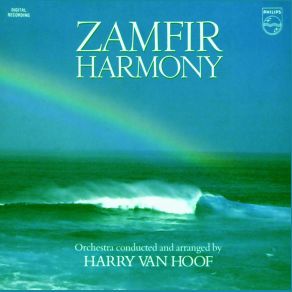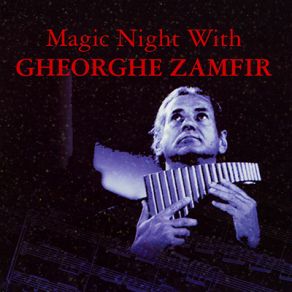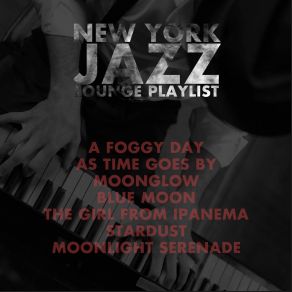Gheorghe Zamfir
Wikimp3 information about the music of Gheorghe Zamfir. On our website we have 41 albums and 42 collections of artist Gheorghe Zamfir. You can find useful information and download songs of this artist.
Biography
[Edit]Thanks to countless TV ads hawking collections of his music, Zamfir is almost universally recognized as the "Master of the Pan Flute." While that title may be cause for smirking in some quarters — whether because of its overexposure or a general distaste for easy listening music — it's true that Gheorghe Zamfir was single-handedly responsible for popularizing an ancient, traditional Eastern European instrument that was in danger of dying out for lack of interest. Made of bamboo, reeds, or wood, the pan flute (also known as the pan pipes or the nai) consists of a series of tubes, each of which sounds one individual note, and are fastened together side by side. It produces an ethereal, haunting sound, and since its construction makes the execution of up-tempo passages nearly impossible, it's ideal for the sort of slow, tranquil mood music that constituted Zamfir's stock in trade. At first focusing on Romanian folk melodies, classical material, and original compositions, Zamfir's popularity in Europe and America led him to cover pop songs, soundtrack themes, and the like, all supported by soft, lush orchestral arrangements.
Gheorghe Zamfir was born in Gaiesti, Romania, on April 6, 1941. Interested in music from a young age, he learned to play gypsy songs on the accordion while tending his family's goat pasture. At 14, his father enrolled him at the Bucharest Academy of Music, where he switched to the pan flute under the influence of instructor Fanica Luca. He immediately displayed a gift for the nearly forgotten instrument, quickly learning to bend pitches and improvise (skills that were rarely associated with it). He went on to study at Conservatory of Bucharest, where he learned music theory, piano, and conducting. While a student in the '60s, he toured and made some recordings in tandem with Luca; those recordings were discovered by Swiss musicologist Marcel Cellier, who broadcast a radio show devoted to Eastern European folk music. Cellier, who also played the organ, invited Zamfir to Switzerland in 1969, and the two began performing duo concerts together. In the meantime, Zamfir also took over conductorship of the Romanian folk ensemble Ciocirlia, and in 1970 formed his own ensemble. Cellier produced Zamfir's earliest recordings in 1970-1971, and helped promote him around Europe, which led to several releases on the Philips label.
Zamfir caught his big break in the English-speaking world when the British religious television show The Light of Experience adopted his recording of "Doina De Jale" — a traditional Romanian funeral song — as its theme. Popular demand forced Epic Records to release "Doina De Jale" as a single in 1976, and it climbed all the way to number four on the U.K. charts. It would prove to be his only hit single, but it helped pave the way for a consistent stream of album sales in Britain, Australia, America, and continental Europe over the next few decades. The biggest of those albums included Solitude (1973), The Romance of the Panflute (1982), and The Lonely Shepherd (1984). Additionally, he scored several films — most notably 1975's Picnic at Hanging Rock, directed by Australia's Peter Weir — and had a European hit in 1979 with the theme from the Dutch film Der Verlaten Mijn, a collaboration with arranger James Last. He staged numerous world tours and performed at Carnegie Hall for the first time in 1981; by this time, classical adaptations were coming to dominate his repertoire, which separated him technique-wise from the raft of mostly European imitators that had sprung up during the late '70s.
Many of Zamfir's recordings aimed to create a sense of spiritual tranquility, and some of his compositions were religious in nature. That preoccupation resulted in his exile from Romania in 1982, when he violated official Communist doctrine by declaring at a concert that his music was dedicated to God. He emigrated to Montreal, where Western popular music crept ever more firmly into his choices of material. In the United States, ubiquitous TV commercials for his albums made Zamfir a household name. He played on much of Bill Conti's score for The Karate Kid in 1984, and that year also performed the theme for Sergio Leone's Once Upon a Time in America. Zamfir subsequently settled into a comfortable, consistent recording schedule, turning out new product on a regular basis for a variety of labels.
Title: Panfloete und Orchester - Beruehmte Opernarien
Artist: Gheorghe Zamfir, Rumaenische Staatsphilharmonie Arad
Genre: Opera
Title: Pan Flute Christmas (Contempory Versions of Your Favorite Christmas Songs)
Artist: Gheorghe Zamfir
Genre: Kids
Title: Spanish Night II: Concertos For Panpipes, Guitars & Orchestra
Artist: Gheorghe Zamfir, Amadeus Guitar Duo
Genre: Classical
Title: Opera
Artist: Gheorghe Zamfir, Prague National Theatre Orchestra, Peter Vronsky
Genre: Pop, Instrumental, Opera
Title: Spotlight On Gheorghe Zamfir
Artist: Gheorghe Zamfir
Genre: Jazz, Pop, Traditional Pop Music, Smooth Jazz
Title: Selection Gheorghe Zamfir
Artist: Gheorghe Zamfir
Genre: New Age, Jazz, World Music, Smooth Jazz
Title: King Of The Pan Flute And Other Favorites
Artist: Gheorghe Zamfir
Genre: Jazz, World Music, Songwriter/Lyricist, Smooth Jazz
Title: Zauber Der Panflöte / Zauber Der Panflote
Artist: Gheorghe Zamfir
Genre: Jazz, World Music, Smooth Jazz
Title: The Magic of the Pan Pipes
Artist: Gheorghe Zamfir
Genre: Jazz, Traditional Pop Music, Smooth Jazz
Collections
Title: Bach for Breakfast - The Leisurely Way to Start Your Day
Genre:
Title: La Flute de Pan, Vol. 1 Les Plus Grands Themes
Genre: World Music
Title: World Music Catalogues
Genre: World Music
Title: Romanian Folk Dances Vol. I
Genre: World Music
Title: Romanian folk dances vol.II
Genre: World Music
Title: Jazz Goes To Broadway
Genre: Jazz
Title: Carnet de voyage musical - Asie Europe
Genre: World Music
Title: A Popular Mix of Hits
Genre: Pop
Title: A Mix of Popular Hits
Title: An Instrumental Christmas
Genre: Pop
Title: Celeste 1991 - 1993
Genre: Electronica, Pop, Theatre/Soundtrack
Title: Golden Instrumental Greatest Hits
Genre: Instrumental
Title: Super Instrumental 3
Genre: Instrumental, Classical
Title: Super Instrumental 5
Genre: Latin, Pop Rock, Instrumental
Title: Super Instrumental 6
Genre: Instrumental
Title: Super Instrumental 8
Genre: Instrumental
Title: Super Instrumental 12
Genre: Instrumental
Title: Super Instrumental 14
Genre: Instrumental
Title: 20 Oscar Winning Songs Vol. 2
Genre: Theatre/Soundtrack, Instrumental
Title: The Best Of LoungeLegends - February 2013
Genre: Instrumental
Title: Lounge Legends Goes Classics 7
Genre: Instrumental, Classical
Title: Nice And Easy Collection - Edition IV
Genre: Instrumental
Title: The LoungeLegends Goes Classic Vol. 8
Genre: Instrumental, Classical
Title: 100 Film Classics (CD2)
Genre: Electronica, Soul, Jazz, World Music, Latin, Pop, Theatre/Soundtrack, Funk, Classical
Title: Top 100 Instrumental Hits (CD1)
Genre: Instrumental
Title: Top 100 Instrumental Hits (CD2)
Genre: Instrumental
Title: Trance In Motion Vol. 158 (Mixed By E. S.)
Genre: Trance, Vocal Trance, Progressive
Title: My Favourite Hits Of 1977 (CD4)
Genre: Rock, Blues Rock, Disco, Pop, Pop Rock, Synth Pop, Acoustic
Title: The Greatest Movie Ballads (Soundtrack)
Genre: Soul, Pop, Theatre/Soundtrack
Title: Classico: Klassik Mit Popstars
Genre: Pop, Classical Crossover
Title: The Magic Of Classical Music: Brahms (CD6)
Genre: Classical
Title: The Magic Of Classical Music: Liszt (CD4)
Genre: Classical
Title: Classical Creations: Liszt (CD3)
Genre: Classical
Title: Classics For Coffee: Liszt (CD3)
Genre: Classical
Title: All The Best Vol. 04 (CD1)
Genre: Pop
Featuring albums
Title: Baroque for Beauty Sleep: Sweet Dreams for Beautiful Dreamers
Artist: I. Musici, Iona Brown, James Judd
Genre:
Title: Murmures de la forêt (Forest Murmurs) / Murmures de la foret (Forest Murmurs)
Artist: Various Artists
Genre:
Title: The Music of Eastern Europe
Artist: Various Artists
Genre: World Music, Instrumental, Instrumental
Title: My Personal Favourites (CD1)
Artist: James Last
Genre: Orchestral, Instrumental, Orchestral, Instrumental
Title: Dansuri Populare Românești, Vol. 2 / Dansuri Populare Romanesti, Vol. 2
Artist: Various Artists
Genre: Country
Title: Culegere De Cântece Românești, Vol. 6 / Culegere De Cantece Romanesti, Vol. 6
Artist: Various Artists
Genre: Pop
Title: Música Clásica para Relajación / Musica Clasica para Relajacion
Artist: Various Artists
Genre: Classical
Title: Die Schönsten TV- Und Filmmelodien / Die Schonsten TV- Und Filmmelodien
Artist: James Last
Genre: Pop
Title: Originalmusik Aus Der Fernsehserie " Lorentz & Söhne "
Artist: James Last
Genre: World Music, Instrumental, Folk, Instrumental

























































































































